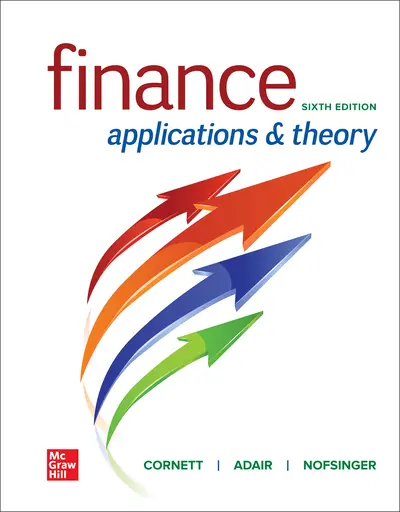My Account Details

ISBN10: 1264101589 | ISBN13: 9781264101580

* The estimated amount of time this product will be on the market is based on a number of factors, including faculty input to instructional design and the prior revision cycle and updates to academic research-which typically results in a revision cycle ranging from every two to four years for this product. Pricing subject to change at any time.
Instructor Information
Quick Actions (Only for Validated Instructor Accounts):
Finance: Applications and Theory is an introduction to corporate finance, focusing on how companies invest in real assets, raise the money to pay for the investments, and how those assets affect the value of the firm. The sixth edition continues to provide the core concepts for the undergraduate corporate finance course, to parallel and support how instructors from across the country teach finance. Also, this is the first text to use individual examples to help students better understand the material. The framework of this text helps students understand how to approach core financial concepts by emphasizing three themes:
- Finance is about connecting core concepts
- Finance can be taught using a personal perspective
- Finance focuses on solving problems and decision making
Part One: Introduction
Chapter 1: Introduction to Financial Management
Part Two: Financial Statements
Chapter 2: Reviewing Financial Statements
Chapter 3: Analyzing Financial Statements
Part Three: Valuing of Future Cash Flows
Chapter 4: Time Value of Money 1: Analyzing Single Cash Flows
Chapter 5: Time Value of Money 2: Analyzing Annuity Cash Flows
Part Four: Valuing of Bonds and Stocks
Chapter 6: Understanding Financial Markets and Institutions
Chapter 7: Valuing Bonds
Chapter 8: Valuing Stocks
Part Five: Risk and Return
Chapter 9: Characterizing Risk and Return
Chapter 10: Estimating Risk and Return
Part Six: Capital Budgeting
Chapter 11: Calculating the Cost of Capital
Chapter 12: Estimating Cash Flows on Capital Budgeting Projects
Chapter 13: Weighing Net Present Value and Other Capital Budgeting
Part Seven: Working Capital Management and Financial Planning
Chapter 14: Working Capital Management and Policies
Chapter 15: Financial Planning and Forecasting
Part Eight: Capital Structure Issues
Chapter 16: Assessing Long-Term Debt, Equity, and Capital Structure
Chapter 17: Sharing Firm Wealth: Dividends, Share Repurchases, and Other Payouts
Chapter 18: Issuing Capital and the Investment Banking Process
Part Nine: Other Topics in Finance
Chapter 19: International Corporate Finance
Chapter 20: Mergers and Acquisitions and Financial Distress
Accessibility
Creating accessible products is a priority for McGraw Hill. We make accessibility and adhering to WCAG AA guidelines a part of our day-to-day development efforts and product roadmaps.
For more information, visit our accessibility page, or contact us at accessibility@mheducation.com
Need support? We're here to help - Get real-world support and resources every step of the way.